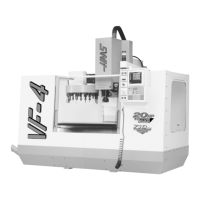1-15-96 96-8100
9
TABLE OF CONTENTS
HAAS AUTOMATION, INC.
TROUBLESHOOTING
SERVICE
MANUAL
VF-SERIES
3. SERVO MOTORS / LEADSCREWS
3.1 NOT OPERATING
All problems that are caused by servo motor failures should also register an alarm. Check the alarm history to deter
mine the problems cause before any action is taken.
´ Servo motor is not functioning.
l Check the power cable from rear electrical cabinet to ensure connection is tight.
l Encoder is faulty or contaminated (Alarms 139-142, 153-156, 165-168, 182-185). Replace motor assembly
l Open circuit in motor (Alarms 139-142, 153-156, 182-185). Replace motor assembly ("Axis Motor Removal /
Installation").
l Motor has overheated, resulting in damage to the interior components (Alarms 135-138, 176). Replace motor assem
bly ("Axis Motor Removal/Installation").
l Wiring is broken, shorted, or missing shield (Alarms 153-156, 175, 182-185).
l Dust in the motor from brushes has shorted out the motor (Alarms 153-156, 175, 182-185). Replace motor
assembly ("Axis Motor Removal/Installation").
l Motor has overheated; no damage to the interior components. OVERHEAT alarm has been triggered. After thorough
check of motor (DO NOT DISASSEMBLE!), take necessary steps to eliminate the problem and alarm to resume opera
tion. If motor is still inoperable, replace motor assembly ("Axis Motor Removal/Installation").
l Check for broken or loose coupling between the servo motor and the lead screw. Replace or repair the coupling ("Axis
Motor Removal/Installation")
l Check for a broken lead screw. If cracked or broken, replace ("Lead Screw Removal and Installation" section).
NOTE: If a lead screw fails, it is most often due to a failed bearing sleeve. When replacing the lead screw in an older
machine, always replace the bearing sleeve with the current angular contact bearing sleeve ("Bearing Sleeve Removal
and Installation" section).
3.2 NOISE
Lead screw noise is usually caused by a lack of lubrication and is usually accompanied by heating. Other causes are
misalignment, bearing sleeve damage, or ball nut damage. Check the alarm history of the machine and look for axis
overcurrent and following error alarms.
NOTE: Do not replace lead screws or bearing sleeves without due consideration; they are extremely durable and reli
able. Verify that customer complaints are not due to tooling, programming, or fixturing problems.
´ Servo motor noise.
l Disconnect the servo motor from the lead screw and rotate by hand. If the noise persists, replace the motor assembly
("Axis Motor Removal/Installation" section).
l Noise is caused by motor brushes. No problems will occur and noise should eventually go away.
l Noise is caused by bearings. Rolling, grinding sound is heard coming from the motor. ENSURE NOISE IS
NOT COMING FROM THE BRUSHES. If bearings are making a consistently loud sound, replace the bearing sleeve.

